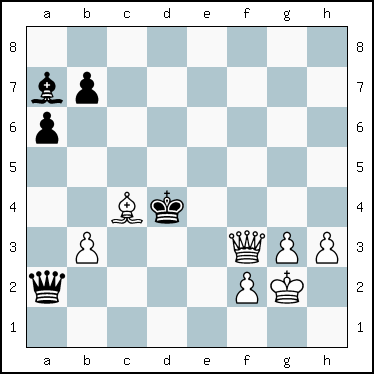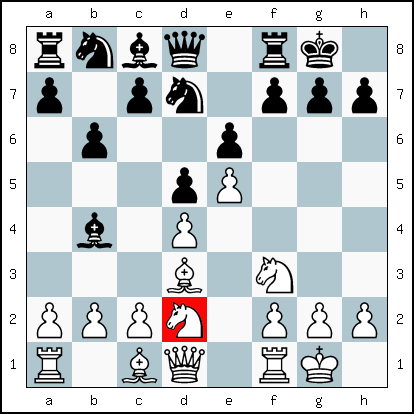
Contenuto di questa lezione: patterns tratti dal libro FCP (Fundamental Chess Patterns), con molti diagrammi e partite di esempio.
Si comincia con una breve partita di Giacchino Greco, il Calabrese, dove all'allievo è richiesto di identificare due patterns.

Per linee o colonne o in diagonale. Due versioni, con Re contro il bordo basta la Donna sola, o se il Re è avanzato, con Donna sostenuta
Potete vedere molte partite di esempio e scaricare il PGN
qui
(http://scacchi.vecchilibri.eu/partite/epaulette.html)
per vedere le altre la lista si ottiene cliccando sui puntini
Le considerazioni che seguono si trovano nell'Encyclopedia.
This is an Epaulette mate, where the two pieces blocking the escape of the King are like the shoulder pieces of a uniform.
The above diagram shows three versions: if the King is along the edge of the board (upper left diagram), then a Queen alone is enough to block the two escape squares (b7 and d7). If the King is not against the side of the board, then the Queen needs to be supported (e.g. by the King, as shown in the bottom and upper right diagrams). The upper right position (with diagonal escape squares) is also known as the Dovetail mate.
To block the King's escape, it is also possible to have any of following white pieces on c3: a Rook, a Queen, or a Bishop. It is also possible for c3 to be empty, but in this case the square must be controlled by a black piece (e.g. a black Knight on a4), so take note.
The Shortest Game

The Wayward Queen Attack (ECO C20, also known as the Parham Attack, Patzer Opening or Kiddy Opening) is characterized by the following moves:
1. e4 e5
2.  h5
h5
This opening violates normal opening guidelines by developing the Queen too early. Bernard Parham is the first master-level player known to have advocated this line.
Black's worst possible response is  e7:
e7:
1. e4 e5
2.  h5
h5  e7 ??
e7 ??
3.  xe5# 1-0
xe5# 1-0
V.S. Weinstein (or Boris Samilovich Vainstein, nickname Ferzbery) Combinations and traps in the opening, page 19, "Here Black wanted to play with his Queen to protect the pawn on e5, but by mistake he touched his King instead. According to the rules he had to play with his King".
Example games:
Quoting Eric Schiller: "The player of the Black side went on to become a fine journalist but never became a rated player. It was a real, if casual, game and I soon abandoned 2.Qh5 for the Ruy Lopez."
This position can be found in a so called "proof game" problem by Joost De Heer, 1996, http://abrobecker.free.fr/chess/IntroductionToPGs.pdf , where White and Black cooperate to reach a diagrammed position in a stipulated number of moves. Worthwhile to investigate when you are tired of blitz games.
Nine Dots Puzzle

To help with identification of the Dovetail mate, look at the puzzle above. The test consists of connecting all 9 dots with 4 straight connected lines without lifting the pencil from the paper.
A young person can do it in a few minutes, an adult might take an hour, if they can even do it. Typically, it takes 15 minutes.
A hint: the key to the solution (yes, there is one!) is an open mind.
The nine dots puzzle is a century old, appearing in Sam Loyd's 1914 Cyclopedia of Puzzles, entitled Christopher Columbus's egg puzzle. The expression "thinking out of the box" is especially common in connection with business, particularly when talking about finding solutions to problems, developing new concepts or changing the way that people work.

To solve this puzzle you need to think outside of the box with an open mind -- an essential skill when playing chess.
The Pattern to Remember

Consider the nine squares c4-c5-c6 d4-d5-d6 e4-e5-e6 (the rest of the board is blurred). The Queen on e4 controls 6 squares (red lines), and the Bishop on the a3-f8 diagonal controls the other 2 squares (red line). The King on the center square is mated, with no safe square left.
The pattern is similar to the 9-dots puzzle, being so easy to remember. The game on the following page shows an example of a mate in the center of the board, with just a few pieces remaining -- a very rare occurrence.

41.  f3+
f3+  d4 ?? White to move
d4 ?? White to move

Rare mate in the middle of the board
42.  e3# 1-0
e3# 1-0
From the game lapaget vs. aggressiveleo, GameKnot Blitz, 2015.08.03

Mossa al Bianco: vince con matto.
Luca Pacioli, nel suo MS De ludo scachorum (latino per Sul gioco degli scacchi), datato 1498 e ristampato recentemente
(Gli scacchi) da Aboca Museum Edizioni, mostra un raro matto di Re + Cavallo contro Re + pedone.
Soluzione :
1.  f3
f3  a1
a1
2.  d4
d4  a2
a2
3.  e2
e2  a1
a1
4.  c1 a2
c1 a2
5.  b3#
b3#
Per trovare la soluzione, invece di provare, conviene notare l'unico modo di dare matto, e tornare indietro.
Percorso alternativo: 1.  e4
e4  a1 2.
a1 2.  c5
c5  a2 3.
a2 3.  d3
d3  a1 4.
a1 4.  c1 a2 5.
c1 a2 5.  b3#
b3#
Se la mossa è al nero è patta: 1. ...  a1
2.
a1
2.  c4 a2 3.
c4 a2 3.  b2 o qualsiasi altra sequenza di mosse.
b2 o qualsiasi altra sequenza di mosse.
Una partita moderna che porta a un finale simile si può vedere qui: Pacioli n. 23 http://scacchi.vecchilibri.eu/partite/pacioli.html
segue il foglio manoscritto originale, di difficile lettura, lo stile di scrittura è vecchio di 500 anni. I 114 problemi che contiene, erano usati per scommesse, difficili da vincere per i vincoli che bisognava rispettare, come qualche pezzo che non poteva essere catturato, matto da dare in un numero esatto di mosse, matto da dare da un pezzo specifico.


+/-
I recently found a similar position called "Stamma's mate", with the Knight on d3, on Wikipedia.
As reported by Emms, John (2004), Starting Out: Minor Piece Endgames, page 122.
In the diagram showing Stamma's mate (named for Philipp Stamma 1705-1755), White to move wins:
1. Nb4+ Ka1
2. Kc1 a2
3. Nc2#
White also wins if Black is to move first:
1. ... Ka1
2. Nc1 a2
3. Nb3#
Stamma was considered one of England's strongest players. His book introduced algebraic chess notation in an almost fully developed form before the now obsolete descriptive chess notation evolved.
This checkmate has occurred in actual games, see the game between Jesus Nogueiras and Maikel Gongora from the 2001 Cuban Championship.
A modern game leading to a similar endgame can be seen here: Stamma (http://scacchi.vecchilibri.eu/partite/pacioli.html)
A similar position in Luigi Milani, Il giuoco degli scacchi, 1922, page 449.

This position, (Ending 14 in De La Villa - 100 Endgames) was played by IM Sergio Estremera in one blitz game on ICC. The sequence is similar to Stamma's mate, leaving no square available to the Black's King, obliging the pawn to move, and then checkmating:
1. Nc1 a2
2. Nb3#
Chapter 3 of the book is devoted to Knight vs. Pawn endings. He considers positions with a 7th-rank pawn, a Knight's pawn, a 6th-rank Rook's pawn, a 7th-rank Rook pawn, the Knight's dumb square and the way for the Knight to set up a barrier.
I suggest this book for a deep understanding of the strategies of each ending.

Si mostra il sacrificio dell'alfiere in h7 nella partita di Gioacchino Greco, e si chiede come può rispondere il Nero, e come può attaccare il Bianco. Fare notare la mossa chiave Dxf7.
Dopo altre partite di esempio, si illustrano i criteri per l'attacco e la difesa.
Analisi completa su Ian Andersen, Chess Visualization Course Book2: Kingside Sacrifices and Combinations
Un riferimento è anche Vladimir Vukovic: Art of Attack, cap 6
Interessante la monografia di David Rudel: The Greek gift Bxh7 - Master both sides of chess.
Potete vedere molte partite di esempio e scaricare il PGN qui (http://scacchi.vecchilibri.eu/partite/greekgift.html)
This example (green arrow aiming at h7) is a much more difficult pattern than most of the rest of the book. It is a complex position with many variations - some where the sacrifice works and some where it does not.
Since a thorough analysis is beyond the scope of this handbook, the focus will be on recognizing the danger when you are on the receiving end. (While it can be fun to try this as the attacker in a casual game, you will often find yourself down a piece rather than winning.)
For the pattern to be correct, the following is needed:
black Knight not on f6
a white pawn on e5
no Bishop on e7
a white Bishop on b1-h7 diagonal
the other Bishop on c1-h6 diagonal
the Knight can reach g5
the Queen can reach h5 or h3
A possible continuation:
1.  xh7+
xh7+  xh7 (also
xh7 (also  h8)
2.
h8)
2.  g5+
g5+  g8 (often
g8 (often  g6)
3.
g6)
3.  h5
h5  e8
4.
e8
4.  xf7+
xf7+  h8
5.
h8
5.  h5+
h5+  g8
6.
g8
6.  h7+
h7+  f8
7.
f8
7.  h8+
h8+  e7
e7  xg7#
xg7#
The above sequence is well known, with the two variants shown. It can be
found almost everywhere, even in movies. In most books where it appears,
the aim is to show a trap or a tactic and not to teach all the elements
required to master this pattern.

If Black defends (red arrow aiming to e7 and so
controlling g5) with  e7, it is not the
pattern.
e7, it is not the
pattern.

Not the pattern, because  d2 obstructs
d2 obstructs  c1
c1
This situation can be reached in a Ruy Lopez, a Reti, a Slav, or a Queen pawn opening, and it can exist even if White did not castle.
For a complete analysis of this specific pattern, look in the bibliography for the work of Alessandro Leoni and of Ian Andersen (hundreds of pages of analysis).
A famous game by Gioachino Greco, also known as Il Calabrese (an Italian region), 1619, a standard sequence still after 400 years, can be seen here: Greek gift http://scacchi.vecchilibri.eu/partite/greekgift.html.